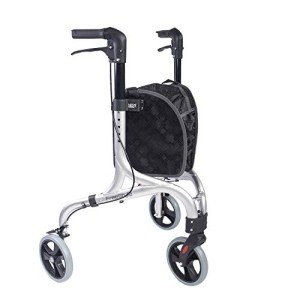
Rollator For Elderly
Add a review FollowOverview
-
Posted Jobs 0
-
Viewed 49
Company Description
10 Healthy Habits For Seat Walker
The Seat Walker: A Comprehensive Guide to Mobility Aids
When it concerns preserving independence and mobility, people with minimal mobility or impairments frequently count on different assistive devices. One such device that increasingly pertains to the leading edge of mobility aids is the seat walker. This post offers an extensive look at seat walkers– their features, benefits, types, and the elements to think about when picking one.
What is a Seat Walker?
A seat walker is a flexible mobility aid created mostly for people who might have problem walking unaided. It normally features a frame with wheels, deals with for support, and an integrated bench or seat, enabling users to take breaks when required. Unlike basic walkers or rollators, which just use assistance for walking, the addition of a seat makes the seat walker substantially more practical for numerous users.
Secret Features of Seat Walkers
- Wheels: Most seat walkers are geared up with front wheels that enhance mobility and ease of use, permitting users to move smoothly over numerous surface areas.
- Seat or Bench: The most distinguishing function is the integrated seat, which provides a resting place for users when tiredness sets in.
- Manages: Adjustable deals with cater to different user heights, offering adequate assistance and guaranteeing a comfortable grip.
- Brakes: Safety brakes prevent the walker from rolling away when somebody is seated, improving user security.
- Lightweight Four-Wheeled Rollator for Easy Mobility Frame: Many designs are developed to be Lightweight 4-Wheel Mobility Walker with Seat, making them much easier to transport and maneuver.
Benefits of Using a Seat Walker
Seat walkers have numerous benefits that make them a perfect choice for many users.
- Enhanced Mobility: They supply higher stability and support than standard walkers, decreasing the risk of falls.
- Convenience: The ability to rest at any point makes them appropriate for those who tire easily or have limited endurance.
- Self-reliance: Seat walkers permit users to preserve a degree of self-reliance by enabling them to stroll and rest without assistance.
- Versatility: Suitable for both indoor and outdoor use, these walkers can adjust to various environments.
- Exercise: Regular use encourages physical activity and social interaction, which can enhance overall well-being.
Kinds Of Seat Walkers
Various types of seat walkers cater to the varying requirements of users. Here is a breakdown of the most common types:
| Type | Functions | Best For |
|---|---|---|
| Fundamental Seat Walker | Easy style, typically with a lightweight frame and very little functions. | Users needing fundamental mobility support. |
| Durable Seat Walker | Reinforced frame, higher weight capacity, frequently with bigger seats. | Individuals requiring more robust support. |
| Rollator For Walking with Seat | Combines seats with multi-height adjustable handles and better maneuverability. | Users needing regular resting alternatives. |
| Transport Seat Walker | Developed for simple transportation; often folds and has a small footprint. | Active users who travel regularly. |
Picking the Right Seat Walker
Choosing a seat Helavo Foldable All-Terrain Walker with Seat includes a number of factors to consider to ensure it satisfies the user’s particular needs. Here are necessary factors to keep in mind:
- Weight Capacity: Ensure that the seat walker can support the user’s weight comfortably.
- Seat Height: Check the height of the seat to ensure it is proper and comfy for the user.
- Width: Consider your home and guarantee the walker can fit through doors and narrow passages.
- compact four wheel walker With seat – lightweight Size: Larger wheels can manage rougher terrain, while smaller wheels are much better suited for indoor use.
- Weight of the Walker: A lightweight Walker With Wheels is beneficial for easy maneuverability and transport.
- Brakes and Safety Features: Look for reliable brakes and safety assurances, such as stability and anti-tip features.
Setting a Budget
Seat walkers vary substantially in cost depending upon their functions and develop quality. While it’s vital to find a design that meets the user’s requirements, it’s equally essential to set an affordable budget.

Average Price Ranges:
- Basic Models: ₤ 50 to ₤ 150
- Rollators with Added Features: ₤ 150 to ₤ 300
- Sturdy Models: ₤ 300 and up
FAQs About Seat Walkers
Q1: Who must use a seat walker?A1: Seat walkers are ideal for people with minimal mobility due to age, injury, or chronic conditions who need extra support while walking. Q2: Are seat walkers safe?A2: Yes, seat walkers are designed with safety in mind. They typically feature brakes, sturdy frames, and slip-resistant grips. Q3: How do I keep my seat walker?A3: Regularly examine the brakes and wheels for wear and tear.
Clean the frame with a moist cloth and guarantee
screws and elements are tight. Q4: Can seat walkers be used outdoors?A4: Yes, many seat walkers are designed for both indoor and outdoor use, though models with bigger wheels carry out better on uneven surfaces. Q5: How do I understand
which seat walker is right for me?A5: Consult with a health care service provider or physical therapist who can assess your mobility requirements and advise ideal choices based upon your unique situation. The convenience and flexibility of seat walkers make them an important tool for those with mobility difficulties. By offering support, stability, and an opportunity for rest, they empower users to remain active and independent. When choosing a seat walker, people must consider their individual requirements, way of life, and safety to find the best match for them. With the right seat walker, many users can delight in a restored sense of flexibility, boosting their lifestyle and preserving their independence. In summary, whether one is navigating through the home, running errands, or taking pleasure in fresh air in a park, a seat walker can show to be an essential companion, transforming daily activities into workable tasks.